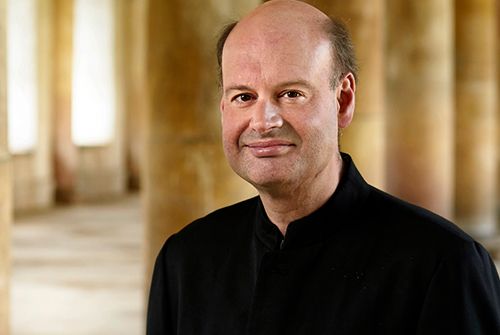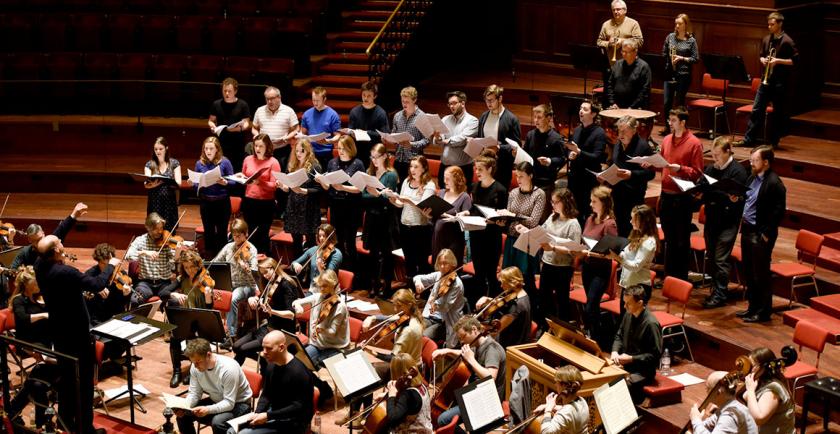Prior to their Messiah, due this evening, Stephen Layton’s choir Polyphony brought a version of Bach’s Christmas Oratorio to the seasonal festival at St John’s Smith Square. You can of course slice and serve Bach’s majestic 1730s combination of musical leftovers (both sacred and secular) and fresh dishes in a variety of ways. But Layton’s choice spun a special mood of its own. With the dozen-strong choir supported by the Orchestra of the Age of Enlightenment, and four luxury-cast soloists, this gig amid the Baroque splendour of St John’s always promised a celebration in high style.
Layton (pictured below), however, rung unexpected changes by giving us Parts 1, 2 and 3 of the Oratorio intercut with another festive favourite: Corelli’s Christmas Concerto, performed after the first part by the OAE strings. That would have disappointed completists who like to hear all six of Bach’s cantatas for separate days of his Leipzig Christmas in a single run. To a degree, the Corelli did break the dramatic flow, but nonetheless it cast its own pervasive spell of gentle, mellow warmth. I’ve heard grander Christmas Oratorios, but few more tenderly involving.
 Four impressive soloists rose to the challenge of balancing joyous triumph and vulnerable intimacy: soprano Anna Dennis, countertenor Hugh Cutting, tenor James Gilchrist and bass Neal Davies. Yet the wonderfully expressive playing of the OAE, led by Margaret Faultless, made an outsize contribution to the evening from first to last. Right at the start, when the trumpet trio, Adrian Bending’s drums and the scurrying strings leapt into “Jauchzet, frohlocket”, the panache and assurance of every instrumental voice rang out. The choir’s blend and balance sounded immaculate in the chorales, and Layton’s decisive leadership gave the recitatives pace and point.
Four impressive soloists rose to the challenge of balancing joyous triumph and vulnerable intimacy: soprano Anna Dennis, countertenor Hugh Cutting, tenor James Gilchrist and bass Neal Davies. Yet the wonderfully expressive playing of the OAE, led by Margaret Faultless, made an outsize contribution to the evening from first to last. Right at the start, when the trumpet trio, Adrian Bending’s drums and the scurrying strings leapt into “Jauchzet, frohlocket”, the panache and assurance of every instrumental voice rang out. The choir’s blend and balance sounded immaculate in the chorales, and Layton’s decisive leadership gave the recitatives pace and point.
Cutting’s “Bereite dich, Zion” announced the richness of tone and clarity of diction that lends such distinctiveness to his voice; Davies’s “Grosser Herr” had a compelling authority, in league with David Blackadder’s trumpet, while the always-outstanding Katharina Spreckelsen and the three other OAE oboes made the first of many lyrical excursions to relish. Layton drew the cantata to a close with an almost lazy choral grandeur that prepared the way for the Corelli.
Yes, the concerto made for a sweet transition as the OAE’s full and rich string tones opened up the Italian musical landscape of the previous decades, on which Bach would soon so brilliantly build. And, after all, the Christmas cantatas were designed for separate feast-days and never planned as a unified work. All the same, the interlude could not help but interrupt the drama of the Nativity story as we waited until after the interval for the divine messengers, the shepherds and their magical music to arrive. Traditionalists might have wondered whether some Christmas transport snarl-up had delayed the angels in a celestial traffic jam.
That said, Corelli’s closing pastorale, liltingly delivered by the OAE, painted the scene beautifully for the Annunciation and Adoration to come. In Part 2, Bach’s opening sinfonia – adorned by the flutes and the two oboe pairs, d’amore and da caccia – did feel like a continuation of Corelli, before Gilchrist put his definitive stamp on the Oratorio’s Evangelist role. His later aria, “Frohe Hirten, eilt”, featured not just muscular singing but a gorgeous duet with Lisa Beznosiuk’s flute. As for Cutting’s “Schlafe, mein Liebster”, its purity of tone and depth of feeling gripped and touched. Cutting (pictured below by Olivia da Costa) brings an almost operatic range of emotion to this most perfect lullaby, with an edge of anxiety as well as overwhelming tenderness, while the woodwind voices gave him heavenly support.
 The contrapuntal confidence and precision of the chorales reminded us of the attention to detail that makes Polyphony such a pinpoint instrument, even at the heftiest climaxes. In Part 3, the trumpets – Blackadder, Phillip Bainbridge, Matthew Wells – came back in all their blaze and swagger. Despite their charisma, we still had vocal treats in store: from Dennis and Davies in the high-low dialectic of “Herr, dein Mittleid” against frolicking oboes d’amore, and (again) from Cutting in an irresistible “Schliesse, mein Herze”. Here – as at other points – the width of the SJSS stage added its own measure of visual and aural drama, as the glorious tone and subtle phrasing of Margaret Faultless’s violin solo touched a loftier instrumental peak that any we had heard before. Layton stage-managed the unfolding drama with a deft vigilance, down to the thrilling ambush of the final choral crescendo. The only trouble was that the sheer quality of singing and playing alike left me (at least) hungry for the three absent parts. Next Christmas, let’s have an uncut Bach Nativity with all the trimmings.
The contrapuntal confidence and precision of the chorales reminded us of the attention to detail that makes Polyphony such a pinpoint instrument, even at the heftiest climaxes. In Part 3, the trumpets – Blackadder, Phillip Bainbridge, Matthew Wells – came back in all their blaze and swagger. Despite their charisma, we still had vocal treats in store: from Dennis and Davies in the high-low dialectic of “Herr, dein Mittleid” against frolicking oboes d’amore, and (again) from Cutting in an irresistible “Schliesse, mein Herze”. Here – as at other points – the width of the SJSS stage added its own measure of visual and aural drama, as the glorious tone and subtle phrasing of Margaret Faultless’s violin solo touched a loftier instrumental peak that any we had heard before. Layton stage-managed the unfolding drama with a deft vigilance, down to the thrilling ambush of the final choral crescendo. The only trouble was that the sheer quality of singing and playing alike left me (at least) hungry for the three absent parts. Next Christmas, let’s have an uncut Bach Nativity with all the trimmings.















Add comment